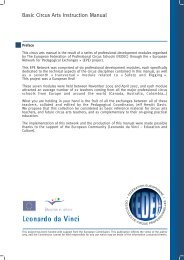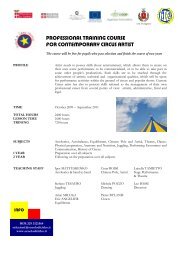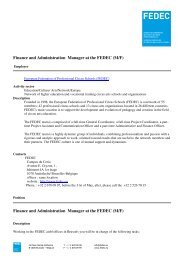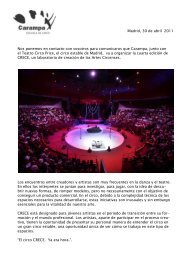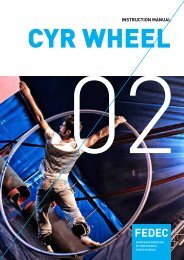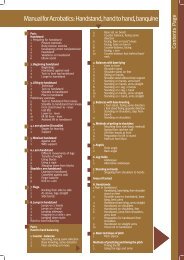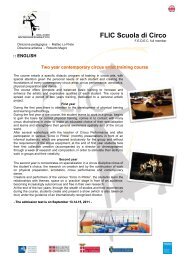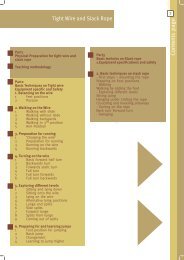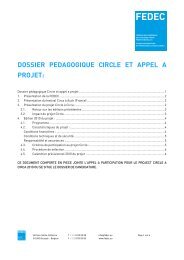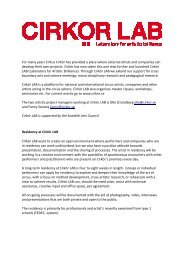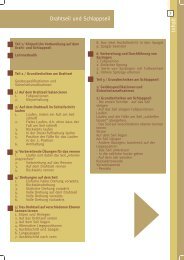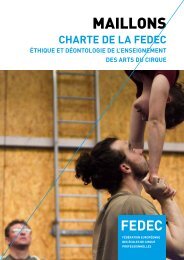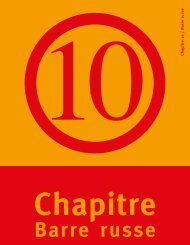Aerial cradle - Fedec
Aerial cradle - Fedec
Aerial cradle - Fedec
You also want an ePaper? Increase the reach of your titles
YUMPU automatically turns print PDFs into web optimized ePapers that Google loves.
Contents Page<br />
Part 1 – Physical Conditioning for Cradle<br />
1. Preparation for catcher<br />
2. Preparation for flyer<br />
Part 2 –'D0 Basics of Cradle<br />
1. Position of performers<br />
1 Catcher<br />
2 Flyer<br />
2. Warm-up & basic static skills<br />
1 Pull ups with flyer<br />
2 Beats in hang<br />
3 Swing to pike through and straddle<br />
4 Full turn in hang<br />
5 Swing pike and catch feet<br />
6 Swing in invert<br />
7 From hands swing to catch legs (backwards)<br />
8 Swing to catch feet backwards (straight)<br />
9 Swing from feet to catch hands forwards<br />
10 Swing from hands to catch feet forwards<br />
11 Forward inverts<br />
12 Swing from feet to catch hands backwards<br />
13 Scissone<br />
14 Front somersault<br />
15 Swing to catch one foot<br />
16 Dislocation<br />
17 Swing to angel<br />
3. Basic swing from catcher<br />
1 Forward Swing<br />
2 Engage (early)<br />
3 Engage (temps tiroir)<br />
4 Engage derriere<br />
5 Remonte from static<br />
6 Remonte from swing<br />
7 Remonte from Pikeswing<br />
8 Depart to pike swing<br />
9 Depart to normal swing<br />
10 Development of depart using floor <strong>cradle</strong><br />
Contents Page
Manual for aerial <strong>cradle</strong><br />
4<br />
1/ Preparation for catcher<br />
The main muscle groups used by the catcher are:<br />
1. The abdominal group<br />
2. The knee extensors (quadriceps, sartorius etc.)<br />
3. The hip flexors<br />
4. The muscles of the shoulder girdle<br />
5. The erector spinae and rhomboid muscles in the back<br />
As you can see the range of strength required for the catcher covers most of the upper<br />
body and torso. It is important that any catcher has undergone physical preparation<br />
before commencing with a flyer. The preparation programme can be split into two parts<br />
1. General conditioning<br />
2. Specific conditioning<br />
part1/ Physical Conditioning for Cradle<br />
The general conditioning involves high repetitions of fairly easy exercises in a circuit. This<br />
can be made harder by increasing the number of reps or decreasing the time allowed<br />
to complete the circuit. A typical circuit involving most of the muscles and actions involved<br />
in <strong>cradle</strong> catching is shown below.<br />
1. Hanging sit –up 2. Dorsal lift on box top<br />
3. Hanging tucks 4. Shoulder stand to lie<br />
5. V-sits 6. Hold dish front and back<br />
1
part1/ Physical Conditioning for Cradle<br />
7. Chins 8. Lumbar lifts<br />
9. Squats with flyer, holding wall bars 10. Sit-ups on box top – feet held<br />
This circuit can be completed with a set time for each exercise, or with a set number of<br />
repetitions for each exercise.<br />
Specific Exercises:<br />
Many of the specific exercises for <strong>cradle</strong> catchers are performed in the <strong>cradle</strong>. Below are<br />
a number of preparations, this list is not exhaustive and there are many more. It is<br />
important to recognise the physical needs and weaknesses of each individual before<br />
setting a strength programme.<br />
1. Curl ups 2. Curl up and extend<br />
3. Swing and hold straight 4. Sit ups from straight<br />
2<br />
4<br />
Manual for aerial <strong>cradle</strong>
Manual for aerial <strong>cradle</strong><br />
4<br />
part1/ Physical Conditioning part1/ for Physical Cradle Conditioning for Cradle<br />
5. Lift from inverted to sit with 6. Dorsal lift from hang<br />
medicine ball (use swing first)<br />
Weights Exercises:<br />
There are a number of weights exercises relevant for catchers, these should be done in<br />
combination with specific exercises on the <strong>cradle</strong> and general conditioning and should<br />
not be considered the only training required.<br />
1. Seated shoulder press 2. Pull downs<br />
3. Leg extensions 4. Upper leg curls<br />
5. Barbell pull-overs 7. Bench press<br />
Exercises using elastic strands (bungees)<br />
Bungees can also be used to good effect in general/specific preparation for <strong>cradle</strong>, some<br />
suggestions are shown below.<br />
3<br />
Physical Conditioning for Cradle
Physical Conditioning for Cradle<br />
part1/ Physical Conditioning part1/ for Physical Cradle<br />
Conditioning for Cradle<br />
2/ Preparation for flyer<br />
The preparation of the flyer is more to do with swing and spatial awareness than pure<br />
strength, but it is important to have excellent body tension and the action of opening<br />
and closing the mid-section also needs to be very strong. For this a number of the<br />
exercises used for the catcher are useful, specifically:<br />
General conditioning: 2,4,5,6 and 8<br />
The following exercises will also benefit the flyer:<br />
1. Piked leg lifts 2. Rocking in dish, forward and backward<br />
3. Straddle leg lifts 4. Tension bridge<br />
4<br />
4<br />
Manual for aerial <strong>cradle</strong>
Manual for aerial <strong>cradle</strong><br />
4<br />
part1/ Physical Conditioning part1/ for Physical Cradle Conditioning for Cradle<br />
5. Half lever, •'5f lift 6. Tick-tocks<br />
7. Handstand against wall 8.Hanging body shapers (Hold 1 sec each)<br />
Along with the preparation of strength there should also be stretching programme. The<br />
most important parts to be stretched for both flyer and catcher are the shoulders and<br />
upper back and, for the flyer, the hips and legs. These exercises are shown in the section<br />
on flexibility, so they will not be repeated at this stage.<br />
5<br />
Physical Conditioning for Cradle
CRADLE BASICS<br />
1/ Positions of performers:<br />
Catcher:<br />
Flyer<br />
The catchers knees go over the near bar and the feet under the far bar.<br />
The ankles should be extended<br />
The knees should be in alignment/parallel<br />
Some catchers like to put the knee bar just below the knee on the top part of<br />
the calf rather than directly underneath the knee.<br />
In hang, he or she should be relaxed and extended, but maintain enough tension<br />
not to be injured by the weight of the flyer<br />
The flyer should hang from the catcher fully extended with the shoulders just<br />
slightly pulled up.<br />
The grip between the two should be on the wrists with fingers 3 and 4 wrapped<br />
around the wrists, 1 and 2 extended along the underside and side of the wrist.<br />
Fig 1 Fig 2<br />
2/ Warm-up and basic static skills<br />
part.2/ Cradle Basics<br />
These exercises and skills can be used as preliminary skills for beginners and later as<br />
a warm-up for more advanced students. Static skills involve the flyer swinging but there<br />
is only a counter swing from the <strong>cradle</strong> by the catcher. The catcher can facilitate the<br />
movements by pushing the flyer forwards or backwards on release.<br />
6<br />
4<br />
Manual for aerial <strong>cradle</strong>
Manual for aerial <strong>cradle</strong><br />
4<br />
1. Pull-ups<br />
2. Swing/beat<br />
Flyer alternates from dish to hollow,<br />
fully extended<br />
The catcher swings in opposition<br />
(counter-swing)<br />
3. Swing to pike, stoop through and<br />
straddle<br />
- Catcher must not block the counter<br />
swing<br />
- The flyer’s shoulders are extended to<br />
allow the legs to come through<br />
4. Full turn on one hand<br />
- The feet must go downwards before the<br />
release of the hand<br />
5. Swing, pike and catch feet<br />
- This is a progression to build confidence<br />
for the correct straight technique<br />
part.2/ Cradle Basics<br />
7
6. Swings in invert<br />
- As per swings from hands<br />
7. Feet swing to hands<br />
- The body should remain straight<br />
throughout<br />
- The arms are kept by the ears<br />
- The catcher can assist by ‘throwing’ the<br />
flyers feet<br />
8. Swing to catch legs<br />
- The flyers feet are placed around the<br />
catchers shoulders<br />
- The flyers feet are flexed<br />
9. Swing to catch feet (straight)<br />
- As in feet to hands the catcher can<br />
assist by ‘throwing’ the hands<br />
10. Feet to hands forwards (straight)<br />
part.2/ Cradle Basics<br />
8<br />
4<br />
Manual for aerial <strong>cradle</strong>
Manual for aerial <strong>cradle</strong><br />
4<br />
11. Hands to feet forwards<br />
- The catcher can assist by widening the<br />
arms slightly before release<br />
12. Feet to hands backwards<br />
- The flyer must continue and develop[p<br />
the backward rotation by pressing the<br />
shoulders upwards and backwards<br />
13. Straddle cut<br />
- The flyer extends the hips and straddles<br />
- By pulling on the catcher he/she can<br />
bring the body up to re-grasp<br />
- The legs should be controlled downwards<br />
14. Front somersault to catch<br />
- The flyers heels should be swinging<br />
towards vertical before releasing the catcher<br />
- Once again the catcher can assist by<br />
‘throwing’ the arms<br />
15. Swing to catch 1 foot<br />
- The non-catching leg must be extended<br />
to counter-balance the body<br />
- The caught foot must be flexed and kept<br />
turned in, as turning out will cause the<br />
body to turn<br />
part.2/ Cradle Basics<br />
9
16. Dislocatio<br />
- From pike, the hips are extended<br />
upwards and backwards<br />
- The arms are rotated outwards and<br />
forwards<br />
- The catcher can assist by opening the<br />
arms<br />
- The body must arch for the swing down<br />
17. Swing to angel<br />
3/ Basic swing from catcher:<br />
The basic swing has been the focus of much debate and the use of techniques founded<br />
in gymnastics swings differ slightly from more traditional ideas. However as has been<br />
seen in the section on biomechanics, in order to maintain an efficient swing and perform<br />
the intermediate and advanced skills on <strong>cradle</strong> it is necessary to comply with the laws<br />
of mechanics. If these laws are met, then differences in certain positions are merely<br />
personal preferences of style.<br />
A/ Forward swing<br />
part.2/ Cradle Basics<br />
At the high point of the swing at the back the catcher is extended and the flyer should<br />
press down on the catcher, with the chest in (concave) and the head in a normal position.<br />
At this point the body is slightly dished.<br />
As the swing develops downwards the feet continue to lead the swing by a small amount.<br />
At a point around 15 – 20 degrees from vertical under the <strong>cradle</strong> the catcher presses<br />
the chest through and allows the feet to drop back creating an arch.<br />
As the swing progresses through vertical this position is developed so the body is<br />
muscularly ‘charged’<br />
10<br />
4<br />
Manual for aerial <strong>cradle</strong>
Manual for aerial <strong>cradle</strong><br />
4<br />
At a point around 15 degrees past vertical the flyer relaxes the back and tenses the<br />
abdominal muscles to create a ‘kick’, allowing the swing to accelerate and lift as high<br />
as possible up the front<br />
Backward swing<br />
part.2/ Cradle Basics<br />
At the top of the swing at the front the flyer must maintain body tension as the swing<br />
develops backwards allowing the feet to slightly lead the swing.<br />
This position is maintained until the flyer is about 20º past vertical when he or she starts<br />
to press forwards upon the catcher so that the chest becomes concave and there is a<br />
slight dish.<br />
The heels continue to rise as the flyer presses downwards, the head is lifted slightly but<br />
not so much that it forces the feet down.<br />
The final position is back to the start point from the picture above.<br />
The swing can be split into three different sections shown in the diagram below. For<br />
reasons of simplification the flyer is shown horizontal without the normal shoulder angle.<br />
11<br />
h
B/ Phase 1<br />
is the swing down section. At the top of the swing there are a number of mechanical<br />
considerations.<br />
1. The moment of inertia is at its greatest as the combined mass of the performers<br />
is furthest from the pivot point<br />
2. The performers have their greatest potential energy due to the height (h) from<br />
the bottom point of the swing<br />
3. At this point they have zero kinetic energy<br />
4. As they have no kinetic energy and their movement is zero there is also no<br />
tangential force acting upon them<br />
5. This point and the corresponding point at the front of the swing are called the<br />
stop points<br />
C/ Phase 2<br />
is the kick phase. Due to the braking effect caused by the limitations of flexion in the<br />
catcher and to lesser extent air resistance, the swing must be accelerated at this phase<br />
in order to rise to a high enough level at the front. Important points:<br />
1. The kick by the flyer finishes past the vertical line at the bottom of the swing. If<br />
it occurs too early the swing will be taken forward and not in the upward direction<br />
of the swing.<br />
2. At this point the flyer also creates a small angle in the shoulders and dishes the<br />
body. The combined effect of this is to decrease the moment of inertia, by<br />
decreasing the length of the body.<br />
3. The muscular action of the flyer kicking forwards is transferred to the swing as<br />
a whole by the transfer of angular momentum principle.<br />
4. This action also allows the catcher to lift the flyer into a correct position at the<br />
front of the swing.<br />
5.<br />
D/ Phase 3<br />
is the upward swing. At this point the performers are fighting against gravity. Important points:<br />
1. The flyer begins this phase with the body shortened to increase rotation<br />
2. As the swing moves up to its highest point the flyer must stretch away as much<br />
as possible and ‘lift’ the catcher to as higher point as possible.<br />
3. As the swing turns around and they begin to swing back the flyer must remain<br />
in the stretched position and the catcher must press in order to stop any angle<br />
developing between the two performers<br />
2/ Engagé (Devant)<br />
part.2/ Cradle Basics<br />
As a progression towards this skill the flyer can bring the legs in immediately at the front<br />
of the swing. The more advanced version and the correct technique is to lay out at the<br />
front of the swing and bring the legs in very quickly once the swing is going back. This<br />
12<br />
4<br />
Manual for aerial <strong>cradle</strong>
Manual for aerial <strong>cradle</strong><br />
4<br />
produces a much stronger swing at the back and allows the progression towards more<br />
advanced skills.<br />
Engagé:<br />
3/ Temps tiroir:<br />
part.2/ Cradle Basics<br />
In the first technique, the flyer pikes in the upward swing and brings the feet through<br />
the hands. In the second technique the body is completed extended throughout the<br />
upward swing and the feet are brought through the hands as the swing starts to move<br />
backwards.<br />
4/ Engagé (derierre)<br />
This is a fairly easy method of getting into a piked swing and can be learned at the<br />
same time as the engagé devant.<br />
13
part.2/ Cradle Basics<br />
5/ Remonté (Remounting the platform)<br />
There are a number of ways to achieve this the simplest of which comes from static<br />
hang and pike.<br />
- The flyer extends the hips upwards and straddles the catcher.<br />
- The flyer then sits up assisted by the catchers hands in his or her back.<br />
- The legs are supported under the catchers arms.<br />
- Once the flyer has grasped the bar the catcher takes one leg and pushes allowing the<br />
flyer to step onto the platform.<br />
6/ Remonté from Swing<br />
This technique can be made easier by performing it from a swing.<br />
7/ Remonté From pike swing (More advanced)<br />
14<br />
4<br />
Manual for aerial <strong>cradle</strong>
Manual for aerial <strong>cradle</strong><br />
4<br />
From temps tiroir, the flyer extends the body on the back swing pushing the hips upwards.<br />
As the catcher comes above horizontal he brings the arms forwards and sits up giving<br />
a support for the flyer to push on and step onto the platform.<br />
8/ Depart to pike swing (Dismounting from the platform)<br />
The catcher lifts the flyer into a piked sit position and then swings back maintaining a<br />
complete extension of the shoulders. As the swing comes under the <strong>cradle</strong> the flyers hips<br />
should drop a little so that the back of the knees are in line with the hips. The flyer can<br />
then extend at the front of the swing.<br />
9/ Depart normal:<br />
part.2/ Cradle Basics<br />
The catcher lifts the flyer into support and the flyer lifts the hips as if lifting towards<br />
handstand, then extends backwards as the catcher swings back. The flyer must extend<br />
the shoulders to avoid a jerk at the bottom of the swing and the earlier this is done the<br />
greater the swing created.<br />
10/ Development of depart using floor <strong>cradle</strong>:<br />
The principles of depart are based upon acro-balance. The catcher must give the flyer a<br />
strong support base and the flyer should be able to hold a good piked sit position and<br />
be able to lift the legs out from there towards handstand. The apparatus set-up shown<br />
below is very useful in teaching these techniques.<br />
15
part.2/ Cradle Basics<br />
Fig 3<br />
The flyer stands on the bar to begin as normal (fig 2) and jumps to piked sit on the<br />
catchers extended arms (fig 3). This can be spotted from the side. From this position<br />
the catcher can extend the hips and fall back flat into the mats.<br />
Fig 4 Fig 5<br />
16<br />
4<br />
Manual for aerial <strong>cradle</strong>



